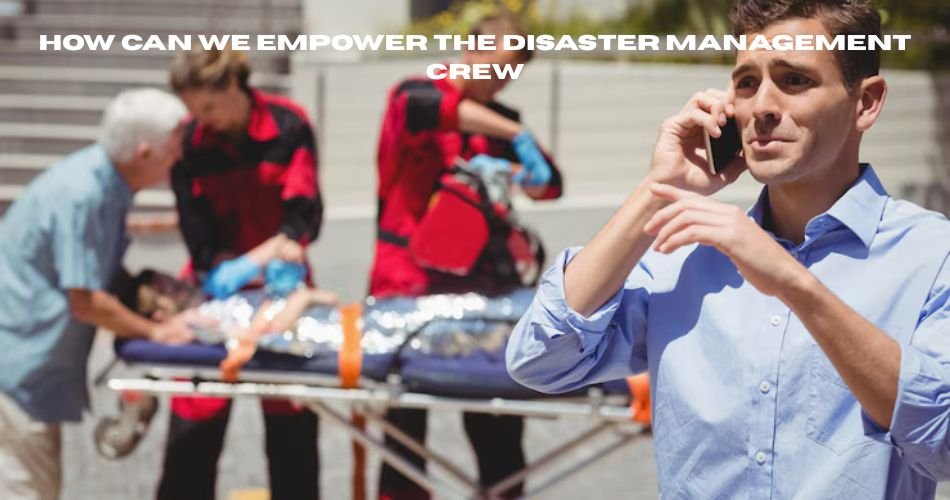How can we empower the disaster management crew to perform at their highest potential during life-threatening crises? In times of disaster, these brave individuals are our first line of defense, risking their lives to save others and restore stability. However, their effectiveness depends greatly on the support, resources, and preparation they receive beforehand. Empowerment means giving them not only advanced equipment but also continuous training, strong leadership, emotional support, and recognition. By addressing these crucial aspects, we can strengthen their capabilities, boost their confidence, and ensure they are always ready to respond swiftly and effectively when disaster strikes.
The Essential Role of Disaster Management Crews
Disaster management crews perform multifaceted roles that extend far beyond immediate rescue operations. Their responsibilities include conducting search and rescue missions, offering medical aid, coordinating evacuation plans, distributing relief supplies, and providing logistical support during emergencies. These professionals work under extreme pressure, often risking their own lives to save others. The environments they operate in are unpredictable, hazardous, and emotionally taxing. Despite these challenges, many disaster management crews operate with limited resources and insufficient preparation, which can hinder their ability to respond effectively. Understanding the critical role they play underscores the need for comprehensive empowerment.
How Can We Empower the Disaster Management Crew by Boosting Confidence and Morale
Empowerment is the cornerstone of an effective disaster response system. An empowered crew operates with confidence, efficiency, and resilience. They are better equipped to make split-second decisions, handle complex scenarios, and adapt to rapidly changing conditions. Empowerment boosts their morale, instills a sense of pride, and enhances job satisfaction. When disaster management crews feel valued and supported, their performance improves, which directly translates into more lives saved and quicker recoveries for affected communities. Thus, empowering these crews isn’t just a moral obligation—it’s a practical necessity.
Training and Skill Development for Excellence
One of the most crucial aspects of empowerment is comprehensive training and skill development. Disaster scenarios are diverse and complex, demanding a wide range of skills. Continuous education programs keep crews updated on the latest response techniques and protocols. Simulation-based training offers realistic practice scenarios, allowing teams to refine their decision-making and coordination skills under controlled stress. Specialized certifications in areas such as advanced medical care, hazardous material handling, crisis negotiation, and technical rescue operations further enhance their capability to manage diverse emergencies. Investing in ongoing training ensures that disaster management personnel remain prepared, competent, and adaptable.
Equipping Crews with Advanced Technology and Tools
Technology serves as a powerful force multiplier for disaster management crews. Providing state-of-the-art communication tools, such as satellite phones and mobile command centers, ensures that teams can maintain contact even in the most remote or devastated areas. Advanced search and rescue equipment, including drones, thermal imaging cameras, and GPS tracking systems, significantly enhance the efficiency and safety of rescue operations. Furthermore, supplying crews with high-quality protective gear, specialized vehicles, and sufficient medical supplies not only improves their performance but also ensures their personal safety during dangerous missions. The integration of technology into disaster response capabilities represents a significant leap forward in empowering these teams.
Supporting Mental Health and Emotional Well-being
The psychological toll of disaster response cannot be overstated. Disaster management crews are frequently exposed to traumatic events, including mass casualties, destruction, and human suffering. Over time, this exposure can lead to burnout, post-traumatic stress disorder (PTSD), anxiety, and depression. Providing comprehensive mental health support is vital. Access to counseling services, stress management programs, peer support networks, and post-traumatic care helps personnel process their experiences and maintain emotional resilience. Encouraging open conversations about mental health and removing the stigma surrounding psychological support fosters a healthier and more sustainable work environment for these responders.
Establishing Strong Leadership and Clear Communication
Effective leadership structures are essential in disaster scenarios where rapid decision-making and coordination are critical. Clearly defined command hierarchies ensure that everyone knows their roles and responsibilities, minimizing confusion during high-pressure situations. Leaders must be trained to make sound decisions quickly, maintain team cohesion, and adapt strategies as situations evolve. Open communication channels, supported by modern communication technologies, enable real-time information sharing, ensuring that all team members stay informed and coordinated. Transparent and effective communication fosters trust and unity within the team, which is indispensable during crises.
Offering Financial Incentives and Professional Recognition
While passion drives many disaster management professionals, financial stability and recognition play significant roles in job satisfaction and retention. Competitive salaries, comprehensive benefits packages, and job security provide responders with peace of mind, allowing them to focus entirely on their mission. Public recognition of their bravery and dedication, whether through awards, media acknowledgment, or community appreciation events, reinforces their sense of purpose. Career advancement opportunities, professional development programs, and clear promotion pathways motivate personnel to continuously strive for excellence, enhancing the overall strength of the disaster management system.
Engaging Communities and Building Partnerships
Empowering disaster management crews extends beyond institutional support—it requires the active involvement of the communities they serve. Engaging local populations in disaster preparedness activities fosters a collaborative environment where everyone shares responsibility. Public education campaigns teach citizens how to respond effectively during emergencies, thereby reducing the initial burden on response teams. Community volunteer programs expand the available workforce during disasters, providing additional hands and eyes on the ground. Strong community partnerships create a sense of shared ownership, enhancing the effectiveness and reach of disaster management efforts.
The Crucial Role of Policy and Government Support
Governments play a pivotal role in empowering disaster management crews through policies, funding, and strategic direction. Strong legislative frameworks that prioritize disaster preparedness, allocate sufficient budgets for resources, and establish clear response protocols create an enabling environment for these teams to operate effectively. Government partnerships with international organizations bring in additional expertise, resources, and global best practices, elevating local capabilities. Policy-level support ensures that disaster management remains a national priority, backed by the necessary political will and financial investment.
How Can We Empower the Disaster Management Crew Through a Culture of Preparedness
Creating a culture of preparedness involves integrating disaster awareness into everyday life. Regular drills and simulations prepare both the crews and the general public to respond calmly and effectively during actual emergencies. Incorporating disaster education into school curriculums instills preparedness values from a young age, building a generation that understands the importance of readiness. Workplaces and community organizations should also participate in preparedness initiatives, ensuring that every segment of society contributes to collective resilience. A well-prepared public not only supports professional responders but also reduces casualties and damage during disasters.
Encouraging Research, Innovation, and Technological Advancement
Ongoing research and innovation are critical to staying ahead of emerging disaster threats. Academic studies offer valuable insights into effective response strategies, while partnerships with technology companies yield cutting-edge tools and solutions. Artificial intelligence-powered predictive models, robotic rescue units, and advanced early warning systems represent some of the innovative frontiers revolutionizing disaster response. Governments and private sectors must invest in research grants and innovation hubs to foster continuous improvement in disaster management technologies and methodologies.
Considering Environmental Sustainability in Disaster Management
As climate change exacerbates the frequency and intensity of natural disasters, integrating environmental considerations into disaster management becomes increasingly important. Sustainable response strategies minimize environmental damage while addressing immediate needs. The use of renewable energy sources in command centers, eco-friendly equipment, and environmentally conscious waste disposal methods during relief operations ensures that disaster management efforts do not contribute to long-term ecological harm. Climate adaptation strategies also help prepare communities for the evolving nature of disaster risks, strengthening overall resilience.
Learning from Past Experiences for Future Improvement
Each disaster presents a learning opportunity. Thorough evaluations of response efforts, often in the form of after-action reports, provide valuable insights into what worked well and what needs improvement. Analyzing case studies and incorporating lessons learned into training and policy updates create a continuous feedback loop that enhances preparedness over time. Encouraging a culture of reflection and adaptability ensures that disaster management crews evolve with each experience, becoming more effective with every response effort.
Conclusion
In answering how can we empower the disaster management crew, it becomes clear that a multi-faceted approach is essential. Providing advanced training, cutting-edge technology, strong leadership, mental health support, and community collaboration all contribute to building a highly capable and resilient response team. Empowerment is not a one-time effort but an ongoing commitment that ensures these heroes are always prepared to face the unexpected. When we invest in their growth and well-being, we strengthen not only their abilities but also the safety and resilience of our entire society. Ultimately, empowering disaster management crews means saving more lives and recovering faster from every crisis.






